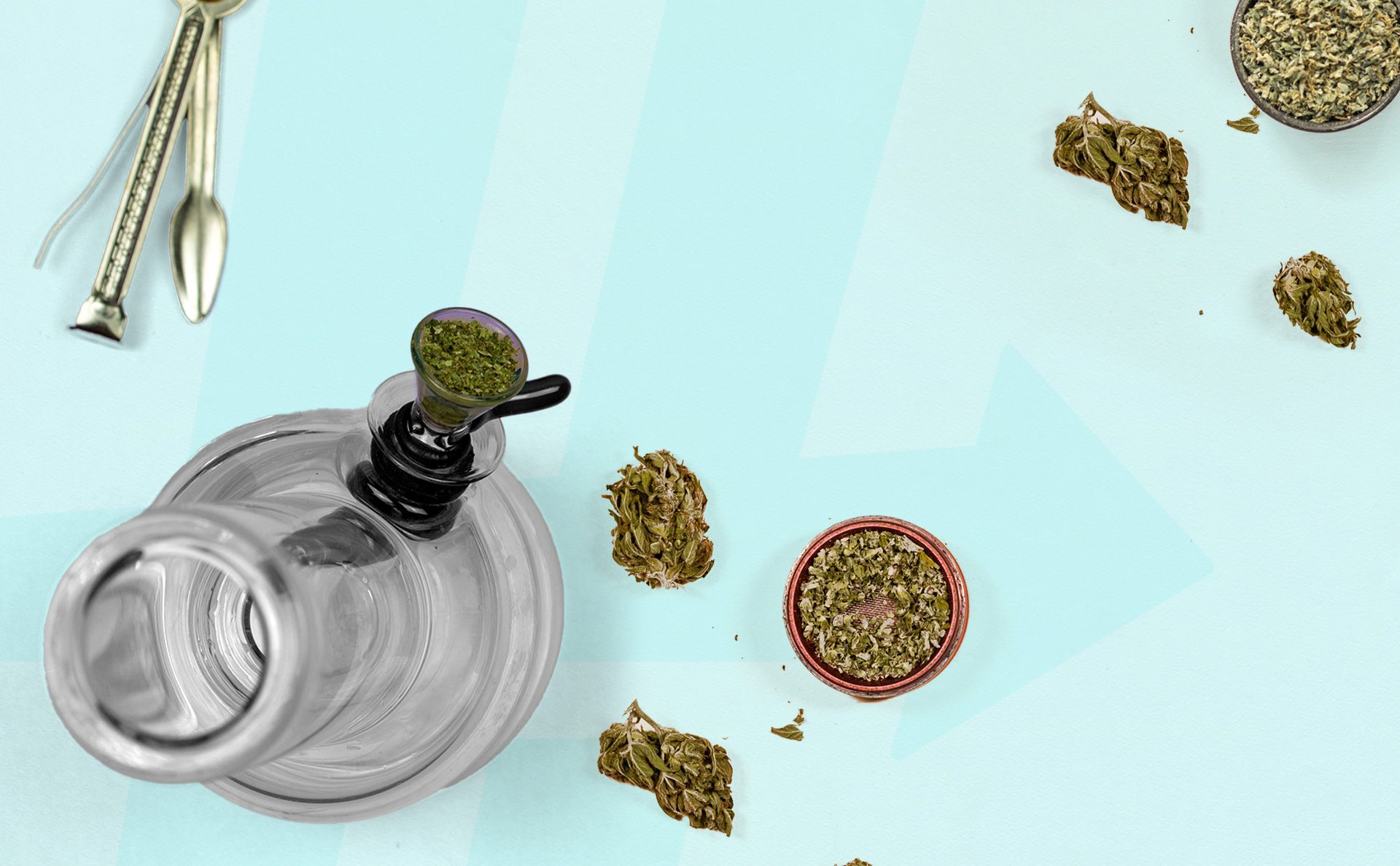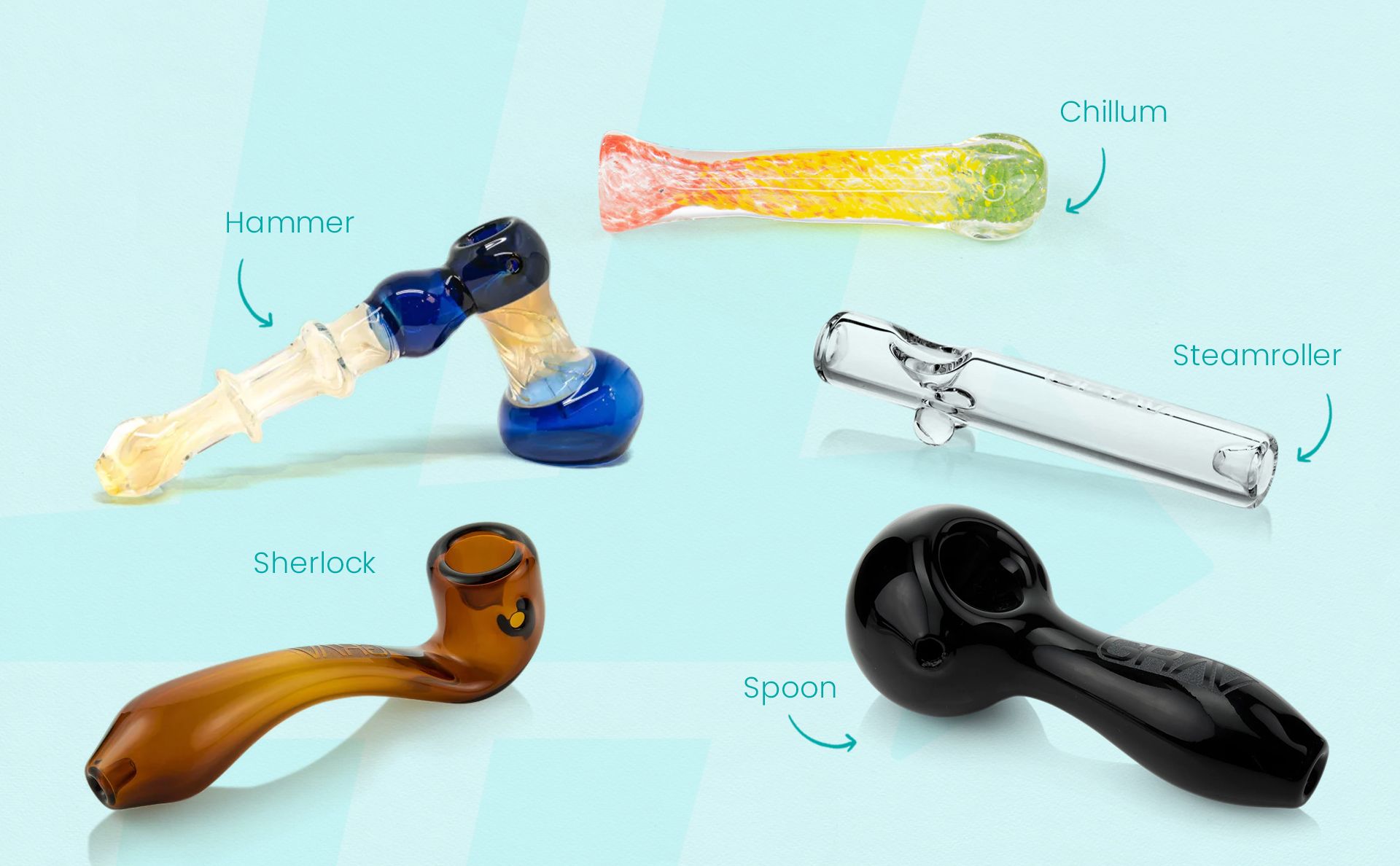Pipes & Bongs
What are Pipes and Bongs? In this chapter of our Consumption Guide, we cover the different types of materials used in these common cannabis smoking devices as well as their legal and cultural impact.

Consumers who smoke cannabis do so often with either bongs or handheld pipes. Pipes are smaller than bongs, easier to use, and portable to carry around. Bongs are typically for use at home, as they are usually much larger than pipes. Cannabis smokers tend to prefer glass pipes and bongs, but there are also devices made from other materials — like wood, metal, silicone, ceramic, and so much more.
Today, smoking out of a pipe may seem outdated and quaint to some cannabis consumers. However, throughout history pipe and waterpipe smoking was seen as a social, intellectual, communal, and even spiritual experience.
The History of Smoking Out of Pipes and Bongs
Smoking herbs out of a pipe may have been the first recorded consumption method. The first recorded use of smoking pipes dates back to the Egyptians, circa 2000 B.C. Since these copper pipes were discovered in the tombs of Pharaohs, historians estimate they may have been used with unidentified sacramental herbs.
It remains unclear as to what those herbs were, but there is some historical evidence that ancient peoples grew and used hemp for various purposes. Historians believe that the first prescribed herbs were done so by Hippocrates, the Greek grandfather of medicine, and the Hippocratic Oath. Hippocrates prescribed “smoking herbs in a pipe” for various ailments.
Archaeologists have found metal and wooden pipes in the ruins and digs of tribes of Greek, Roman, Celtic, and Nordic people. The pipe-smoking of tobacco in the Western world was seen as social and intellectual from the mid-1600s to the late 1800s. Similarly, smoking shisha or flavored tobacco dates back thousands of years to Ancient Asia and was seen as communal, and perhaps even spiritual.
There are also devices called hookahs, which are tobacco pipes that originated in India and evolved in Turkey. Many people think that these pipes called a narghile (pronounced nar-gill-ee) in Turkish, were used for opium or cannabis in Asian parts of the world. However, this is mainly not the case. Instead, flavored Turkish tobacco is inhaled through a hookah. Hot coals are placed on the tobacco and are heated up and smoked.
What Are Pipes?
When most people think of a pipe, they might think of a piece made from glass or wood, shaped like a spoon or with a long stem. There are a multitude of shapes, sizes, and materials of pipes. Some of the main types of pipes for smoking pipes are Sherlocks, spoons, chillums, steamrollers, and hammers aka glass bubblers.

What the expert says...
Dr. Riley Kirk
"The first recorded use of smoking pipes dates back to the Egyptians, circa 2000 B.C. Since these copper pipes were discovered in the tombs of Pharaohs, historians estimate they may have been used with unidentified sacramental herbs."
Main Types of Cannabis Pipes

Sherlocks
These types of pipes get their names because their shapes resemble that which the detective Sherlock Holmes smoked in the 1800s novels by Sir Arthur Conan Doyle. These pipes are some of the most elaborate you will see, especially the pieces of art from skilled glassblowers.
Spoons
Spoons are the same size and shape as the table utensil, hence the name. Spoons are the second-most portable and discreet cannabis pipe. The two most common materials spoons are made from metal and glass, with spoon-shaped metal pipes sometimes sold in gas stations and tobacco stores.
Chillums and Glass Blunts
The most portable types of pipes are chillums and glass blunts. Chillums are much more old-school, and glass blunts have only been around for the last five years or so.
Chillums come in a variety of sizes. The small portable ones are about the size and length of a pinky finger, with the bowl to pack with flowers on one end and the inhalation end on the other. While larger chillums used in more traditional settings are typically larger, about the size of a large cigar; large chillums are typically used by mixing hash with tobacco by hand then packing the top of the chillum and adding a silk screen to the bottom. Glass blunts on the other hand are often shaped like blunts but are made with clear glass and a plastic mouthpiece and an internal construction that causes smoke to swim and dance while inhaling.
Steamrollers
Steamrollers are typically long, glass pieces with a small bowl for packing your flower at the one end. On the other end is where you inhale, and these types of pipes are known for blasting a lot of smoke right into your lungs. Steamrollers are generally not recommended for cannabis newbies.
Hammers aka Glass Bubblers
Hammers are named as such because they resemble a judge’s hammer. The top of the hammer is where you pack your herbs, and the end of the handle is the inhalation point. Due to their size and shape, hammers are often made of glass and filled with water, which is thought to filter out some of the smoke. This is where the device bubblers get their names.
What are Butane Lighters?
Butane lighters are commonly used to light your pipe, bong, or joint. Butane is a highly flammable gas that is used as the fuel in most lighters. While smoking cannabis flower is the least healthy of consumption methods, it remains largely the most popular and available. Inhaling the smoke from any organic plant matter may have adverse effects on the lungs. However, one potentially harmful thing you don’t have to inhale when smoking cannabis is butane from a lighter.
When you are smoking a joint, you only need that lighter for a few seconds to get the joint lit. However, with pipes and bongs, you may need to use that lighter up to 5 times in one session. Studies are scarce, if they exist at all, about whether pipe smokers will in fact inhale butane with their cannabis smoke.
The team at HashDash prefers not to take the risk of inhaling trace amounts of a potentially dangerous chemical like butane when enjoying our cannabis pipes. This is why we recommend purchasing a product like hemp wicks. Hemp wicks are hemp fiber lined with beeswax, you simply take your lighter, light the end of the hemp wick then transfer the flame to your pipe or bong. Lighting up with hemp wick offers a possibly safer, tastier, more terpene-rich inhale. A link to our favorite hemp wick brand is in the sources section of this chapter.
Always Use a Grinder and Pipe Screens
As is the case with rolling your own joint, you will always want to purchase a grinder and grind your cannabis flower before packing a pipe or a bong. Doing so unlocks fuller terpene profiles and allows your cannabis to burn more evenly and slowly than breaking up buds by hand. Not to mention, oils in our skin can degrade compounds in cannabis flower, such as THC.
Depending on the type of pipe you have, how fine you will need to grind your flower will vary. You might also need a screen, which is a piece of metal or sometimes glass. A screen for your pipe prevents you from pulling the fine pieces of herb from the pipe into your mouth.
What Are Bongs?
Water pipes, also called bongs, come in all shapes, sizes, materials, and colors. Bongs are larger than handheld pipes and contain water in the vessel. When you pack your flower into the stem, and then start to pull air through to smoke, the smoke is filtered through the water. There are also glass pieces called bubblers, which are closer in size to handheld pipes but also use water. These glass devices were covered in our pipes section, under the term hammers.
Some cannabis consumers maintain the notion that the water in water pipes filters out potentially harmful irritants while inhaling cannabis smoke. However, there isn’t any concrete evidence to support this idea, just anecdotes and the fact that the smoke tends to feel cooler on the throat and in the lungs with a water pipe.
The cooling of the temperature of smoke is an important part of what makes one consumption method smoother or more desirable than another. When considering purchasing a pipe, water filtration and the length of the pipe are huge factors to consider. Part of why smoking irritates the throat is because the hot air inflames lung and throat tissues. With longer pipes and water cooling the temperature can be brought down allowing for a smoother smoke. You can also add ice cubes to the top of bongs to allow for the smoothest, chillest smoke possible.
With both bongs and water pipes it is imperative that you change the water every single day. Bacteria and fungi thrive in dirty water, and you do not want to compromise the medicinal value of cannabis by smoking from dirty bong water.
As previously mentioned, hookahs are some of the oldest smoking devices. If done properly, the smoke from a hookah is essentially vaporized. As such, the ancient art of consuming hookah is widely thought of as the world’s first vaporizer.
Nowadays, hookahs are generally a novelty, with few cannabis consumers purchasing large devices for smoking at home. Hookah bars for tobacco smoking can be found in lounges near college towns, and we may see a resurgence of them if public cannabis consumption is permitted in more states. However, loading cannabis flower alone into a hookah will cause it to burn up quickly, so some consumers add tobacco to it as well. This causes the same concerns for health-conscious consumers as blunts.
Glass-Blowing Pipe And Bong Community
In a chapter about cannabis pipes, we would be remiss if we didn’t mention the glassblowing community. Legal cannabis is a multi-billion dollar industry, and glassblowing is a relatively decent portion of that.
Glassblowers create some amazing artwork with their creative designs of pipes and bongs of all kinds. Millions of cannabis lovers are unlikely to cease their desire to smoke out of glass pieces anytime soon. Glassblowing courses are now being offered by many universities as both electives for degrees and as returning education.
Glassblowers rightfully take a lot of pride in their craft. Although glass blowing pipes and bongs was a bit of a lost art after Federal Agency-led raids circa the early 2000s, the craft has seen a notable resurgence since legalization in many states. The first elaborate, decorative glass-blown smoking devices are thought to originate from the artist Bob Snodgrass, and his family carries on this artistic legacy.
What We Learned: Pipes & Bongs
The choices of which pipes and bongs to buy will be almost as diverse as that of selecting your favorite cultivar. Here’s what else we learned in our Pipes & Bongs chapter:
- The first recorded use of smoking pipes dates back to the Egyptians, circa 2000 B.C.
- Hippocrates, the Greek grandfather of medicine and the creator of the Hippocratic Oath, prescribed “smoking herbs in a pipe” for various ailments.
- The pipe-smoking of tobacco in the Western world was seen as social and intellectual from the mid-1600s to the late 1800s.
- Devices known as hookahs are tobacco pipes that originated in India and evolved in Turkey and are sometimes used for cannabis purposes.
- Smoking shisha or flavored tobacco dates back thousands of years to Ancient Asia and was seen as communal, and perhaps even spiritual.
- Some of the most common types of cannabis smoking devices include Sherlocks, spoons, chillums, steam rollers, and glass bubblers.
- Using a grinder unlocks fuller terpene profiles and allows your cannabis to burn more evenly and slowly than breaking up buds by hand and avoids degrading these compounds with the oils on your skin.
- Water pipes, also called bongs, are larger than handheld pipes and are filled with water and use what’s called a stem to pack the cannabis.
- Some cannabis consumers maintain the notion that the water in water pipes filters out potentially harmful irritants while inhaling cannabis smoke, but there is no concrete evidence for this.
- The ancient art of consuming hookah is widely thought of as the world’s first vaporizer.
- The first elaborate, decorative glass-blown smoking devices are thought to originate from the artist Bob Snodgrass.
- Butane is a highly flammable gas that is used in most lighters and could be dangerous to inhale. We recommend using a hemp wick with your pipes and bongs to potentially avoid inhaling the chemical butane.
Ready for the next chapter in this Guide? You’re nearing the finish line. Answer the below question to continue your journey of learning.
Citations
- Healthline: How Does a Bong Work?https://www.healthline.com/health/how-does-a-bong-work
- Forbes: Glassblowing Creationshttps://www.forbes.com/sites/davidcarpenter/2018/08/02/cannabis-glass-artist-pipes-bongs-tasty-donuts/#4793a14e2782
- Istanbul Insider: Narghile, Turkish Water Pipehttps://theistanbulinsider.com/nargile-or-turkish-water-pipe-500-years-of-smoking-tradition/
- Wiki: Narghilehttps://en.wiktionary.org/wiki/narghile
- Encyclopedia.com: History of Pipe Smokinghttps://www.encyclopedia.com/history/encyclopedias-almanacs-transcripts-and-maps/pipes
- Philly Tribune: In the 1800s, Pipe Smoking Was Social & Intellectualhttps://www.phillytrib.com/lifestyle/back-in-the-day-pipe-smoking-was-social-and-intellectual/article_d716d1b8-87ec-5ac6-9214-bad3ee761230.html
- First Appearance of Sherlock Holmes Characterhttps://en.wikipedia.org/wiki/A_Study_in_Scarlet
- Snodgrass Family Glasshttp://www.snodgrass.net/
- Bee Line Hemp Wickshttps://www.hempwickbeeline.com/
Test your knowledge, track your progress and earn your badge.
The first recorded use of smoking pipes dates back to what year?

Dr. Riley Kirk
Dr. Riley Kirk is a cannabis research scientist, educator, and advocate. She is passionate about making Cannabis science accessible to everyone through social media channels. The goal of Riley’s work is to unite people in the Cannabis industry, academia, and consumers to further the reach of Cannabis education and destigmatize plant medicine.